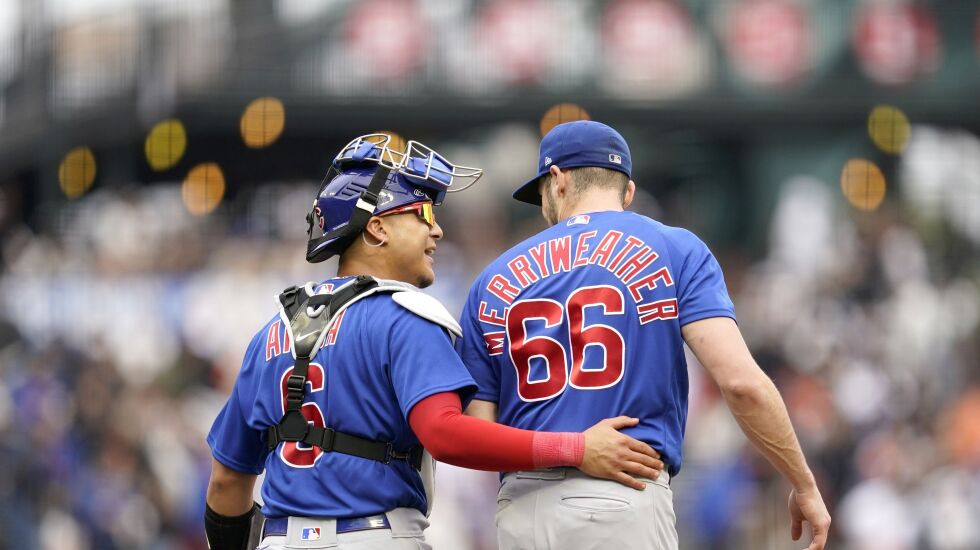
SAN FRANCISCO – Rookie catcher Miguel Amaya tried to anticipate each pitch call before veteran right-hander Kyle Hendricks punched it into the PitchCom device attached to his belt on his right hip.
“I was preparing myself to give a good target,” Amaya said in a conversation with the Sun-Times, “to know what he was trying to do in that moment.”
Catching Hendricks as he carried a no-hitter into the eighth inning of the Cubs’ 4-0 win Saturday against the Giants was another chapter in Amaya’s whirlwind introduction to the major leagues.
Amaya got to know the pitching staff in spring training, in the final stages of his comeback from a string of injuries. But his first time catching many of those pitchers in games came midway through the season, when Yan Gomes’ concussion last month sped up Amaya’s journey to the big-leagues this year.
Amaya didn’t seem phased by the tumult. He garnered compliments from pitchers about his calm presence and dedication to preparation and learning, even while working within the constraints of the pitch clock.
What better learning opportunity than thinking along with Hendircks as he limited the Giants to one hit through eight scoreless innings?
“He’s learning about what Kyle’s doing to the hitter, how hitters are trying to attack, when they’re trying to attack him, reading swings, and gaining knowledge in that and how to call a game,” manager David Ross said.
The technology is new. This is PitchCom’s second year in MLB and the leagues’ first allowing pitchers to call their own games with the devices. But the concept isn’t.
Veteran catcher Tucker Barnhart told the Sun-Times that early in his career with the Reds, All-Star hurler Johnny Cueto would flash a sign when the hitter wasn’t looking to call his own pitches.
“In a way, it helped me learn how to call a game at the major-league level,” Barnhart said of going through the game with Cueto in the moment and watching back video after.
Ross, a former catcher himself, drew on his progression from college to the big-leagues: learning Auburn head coach Hal Baird’s thought process as he called games from the dugout, transferring to Florida and calling his own games with head coach Andy Lopez available for guidance, and figuring out how to read swings and adjust in the minors.
“The way you learn to call a game is experience,” Ross said.
Amaya has already shown promise. Look at the performance of Javier Assad, who Amaya knew from the minors, when he was piggybacking Jameson Taillon’s starts last month. In two outings of five or more innings, with Amaya behind the dish, Assad posted a 1.74 ERA.
At the same time, Amaya impressed Taillon with conversations in between innings.
“He just seems very aware of the scouting report, the pregame meeting that we have, and carrying it out there,” Taillon said. “He’s paying attention. For a young guy, that type of stuff is going to take time until he perfects it, but he wants to be really good at it, which is a great first step.”
Taillon said he’s already noticed a difference over three starts, as he and Amaya have grown more familiar with each other. Taillon wore a PitchCom transmitter in his last start, but he estimated he only called about 10 pitches, when he was adamant about what he wanted to throw next. He said he prefers having his catcher call the game so he isn’t thinking too much on the mound.
“Not every pitcher is wired the same,” Ross said. “I don’t know that [Marcus] Stroman even knows who’s in the box, and he’s going to execute what he does well. Kyle probably knows what each hitter had for breakfast that day.”
After calling his own one-hit start Saturday, Hendricks praised Amaya for his influence.
“Miggy was great back there,” he said. “Just good targets, and we made some great adjustments between innings.”
In particular, Amaya noticed when lefties were crowding the plate, and he and Hendricks tweaked their game plan accordingly.
“That [Saturday] was so valuable, one, for us as a team,” Ross said, “but for Miggy to be able to be a part of that and watch how Kyle dissected the lineup and each hitter, he can learn a lot from that.”







